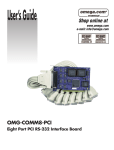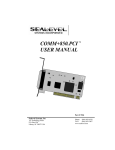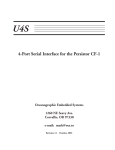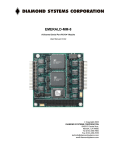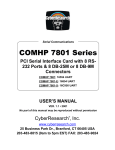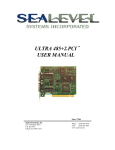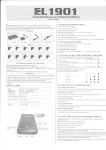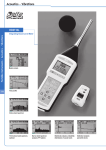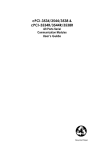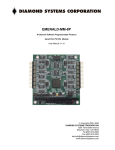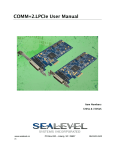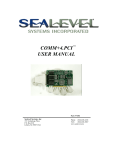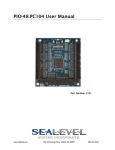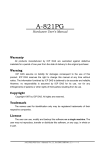Download OMG-COMM8 operator`s manual
Transcript
Contents INTRODUCTION ..................................................................... 1 OVERVIEW ................................................................................. 1 WHAT’S INCLUDED ..................................................................... 1 FACTORY DEFAULT SETTINGS ..................................................... 1 CARD SETUP.......................................................................... 3 ADDRESS SELECTION .................................................................. 3 “PAL” ADDRESSING ................................................................... 4 IRQ SELECTION .......................................................................... 5 INTERRUPT MODE OPTIONS ......................................................... 6 INSTALLATION ...................................................................... 8 OPERATING SYSTEM INSTALLATION ............................................ 8 Windows 3.x, Windows 95, Windows NT................................ 8 OS/2........................................................................................ 8 QNX ....................................................................................... 8 TECHNICAL DESCRIPTION..................................................... 9 FEATURES .................................................................................. 9 INTERRUPT STATUS PORT ............................................................ 9 DB-25 CONNECTOR PIN ASSIGNMENTS ..................................... 10 DB-78 CONNECTOR PIN ASSIGNMENTS ..................................... 10 SPECIFICATIONS .................................................................. 11 ENVIRONMENTAL SPECIFICATIONS ............................................ 11 MANUFACTURING ..................................................................... 11 POWER CONSUMPTION .............................................................. 11 MEAN TIME BETWEEN FAILURES (MTBF) ................................. 11 PHYSICAL DIMENSIONS ............................................................. 11 APPENDIX A - TROUBLESHOOTING ..................................... 12 APPENDIX B - HOW TO GET ASSISTANCE ........................... 14 APPENDIX C - ELECTRICAL INTERFACE ............................. 15 RS-232..................................................................................... 15 APPENDIX D - ASYNCHRONOUS COMMUNICATIONS ........... 16 APPENDIX E - 3421 ADDENDUM .......................................... 17 APPENDIX F - SILK-SCREEN.................................................. 1 APPENDIX G - COMPLIANCE NOTICES ................................ 19 FEDERAL COMMUNICATIONS COMMISSION STATEMENT ............. 19 EMC DIRECTIVE STATEMENT ................................................... 19 WARRANTY ......................................................................... 20 Figures Figure 1 - Address Selection Table ........................................................3 Figure 2 - DIP-switch Illustration..........................................................4 Figure 3 - Headers E1 to E8 (IRQ15 selected).......................................5 Figure 4 - Header E9 and E10, Normal IRQ Mode...............................6 Figure 5 - Header E9 and E10, Shared IRQ Mode................................7 Figure 6 - Header E9 and E10, Sharing IRQ’s with another adapter...7 Figure 7 - DB-25 Connector Pin Assignments ..................................... 10 Figure 8 - DB-78 Connector Pin Assignments ..................................... 10 Figure 9 - Asynchronous Communications Bit Diagram .................... 16 ©1997h Omega Engineering, Incorporated. All rights reserved. Introduction Introduction Overview The Omega Engineering OMG-COMM8-A provides the PC with eight RS-232 asynchronous ports. The OMG-COMM8-A allows for connection to any device utilizing the RS-232 electrical interface, such as modems, data-entry terminals, and plotters. What’s Included The OMG-COMM8-A is shipped with the following items. If any of these items are missing or damaged, contact the supplier. • • • • OMG-COMM8-A Serial I/O Adapter “Octopus” Cable providing 8 DB-25 connectors. 3.5″ Serial Utility Diskette User Manual Factory Default Settings The OMG-COMM8-A factory default settings are as follows: Port # Port 1 Port 2 Port 3 Port 4 Port 5 Port 6 Port 7 Port 8 Base Address 280 288 290 298 2A0 2A8 2B0 2B8 Omega Engineering OMG-COMM8-A IRQ 2/9 3 4 5 2/9 3 4 5 Page 1 Introduction To install the OMG-COMM8-A using factory default settings, refer to the Installation section of this manual. For your reference, record installed OMG-COMM8-A settings below: Port # Port 1 Port 2 Port 3 Port 4 Port 5 Port 6 Port 7 Port 8 Base Address IRQ The following table shows which port is connected to which connector and the corresponding address in the Factory Default setting. Port # 1 2 3 4 5 6 7 8 DB-25# 1 2 3 4 5 6 7 8 Address Base+0 Base+8 Base+16 Base+24 Base+32 Base+40 Base+48 Base+56 Omega Engineering OMG-COMM8-A Example 280-287 288-28F 290-297 298-29F 2A0-2A7 2A8-2AF 2B0-2B7 2B8-2BF Page 2 Card Setup Card Setup The OMG-COMM8-A contains several jumper straps that must be set for proper operation. Address Selection The OMG-COMM8-A occupies 64 I/O locations and can be addressed two different ways. If header E1 is set to the “Switch” position the OMGCOMM8-A occupies 64 consecutive I/O locations and the DIP-switch is used to set the base address for these locations. The starting address for these 64 I/O locations must be on a 64-byte boundary i.e.: Hex 200, 240, 280, or 2C0. Be careful when selecting the base address as some selections conflict with existing PC ports. The following table shows several examples that usually do not cause a conflict. Address 100-13F 180-1BF 240-27F 280-2BF 2C0-2FF 300-3FF 500-53F 580-5BF 1500-153F 1580-15BF 1 On On On On On On On On Off Off 2 On On On On On On On On On On Switch Position Setting: 3 4 5 On On Off On On Off On Off On On Off On On Off On On Off Off Off On Off Off On Off Off On Off Off On Off 6 On Off On Off Off On On Off On Off 7 On On Off On Off On On On On On Figure 1 - Address Selection Table Note: Some of these selections may not be valid for your system, due to port contention. If in doubt, call Sealevel Technical Support (864) 843-4343 for assistance. These addressing restrictions are simplified when using the “PAL” option. Note: If Xenix is the operating system and COM1 is not installed, use base address 500 Hex and IRQ 4 (Xenix COM1:). If COM1: is installed, then select 580 Hex as a base address and IRQ 3 (Xenix COM2:). Omega Engineering OMG-COMM8-A Page 3 Card Setup The following illustration shows the correlation between the DIP-switch setting and the address bits used to determine the base address. In the example below, address 280 (Factory Default) is selected as a base. A12 A6 ON OFF 1 2 3 4 5 6 7 Figure 2 - DIP-switch Illustration Note: Setting the switch “On” or “Closed” corresponds to a “0” in the address, while leaving it “Off” or “Open” corresponds to a “1”. Refer to Appendix A for common address contentions. “PAL” Addressing If header E11 is set to the “PAL” position, the board can be addressed at many customized locations. Using the “PAL” option will allow you to obtain COM1: - COM4: addresses, XENIX COM: addresses, or any other standard or nonstandard address configuration. Using the “PAL” feature is a very cost-effective means of solving complex addressing problems. For more information on implementing the “PAL” option, please contact Omega Engineering Technical Support. Omega Engineering OMG-COMM8-A Page 4 Card Setup IRQ Selection The OMG-COMM8-A has an interrupt selection jumper that corresponds to each port that may have to be set prior to use. The software you are using with the board will determine which interrupts, if any are to be used. The DOS serial port interface software does not use interrupts, while interrupt buffer programs do. DOS does not require the interrupt to be set, while most Multi - User Operating Systems will. Consult the particular manual for the software that you are using to determine the proper setting. To set the interrupt for a particular port, first select the header for the port desired. Headers E1-E8 correspond to Ports 1-8. Next select an IRQ by placing one of the jumpers on the header location that corresponds to the IRQ number that you wish to use. Below is an example of a selected IRQ. 2 3 4 5 6 7 10 11 12 15 Figure 3 - Headers E1 to E8 (IRQ15 selected) Omega Engineering OMG-COMM8-A Page 5 Card Setup Interrupt Mode Options The OMG-COMM8-A will allow each port to have an independent interrupt level or share an interrupt with another port on the adapter. The OMG-COMM8-A will even share interrupts with a compatible port that is located on another adapter. The OMG-COMM8-A can operate in three interrupt modes. Header E9 determines the interrupt mode for Ports 1-4 and header E10 determines the interrupt mode for ports 5-8. “N” indicates the (N)ormal, single interrupt per port mode. “S” Indicates the (S)hared interrupt mode, which allows more than one port to access a single IRQ. Any two or more ports can share a common IRQ by placing the jumpers on the same IRQ setting, and setting the appropriate selections at E5. Consult your particular software for IRQ selection. If no interrupt is desired, remove the jumper. “M” indicates the inclusion of a 1K ohm pulldown resistor required on one port when sharing interrupts. E10 7 8 5 6 N S M 3 4 N S M 2 1 E9 Figure 4 - Header E9 and E10, Normal IRQ Mode Omega Engineering OMG-COMM8-A Page 6 Card Setup Set jumpers to “S” for shared interrupt mode on all blocks sharing an IRQ except one. Set that port block for “M”. This provides the pull-down resistor circuit that makes sharing of IRQ possible. If you are using more than one OMG-COMM8-A or a compatible adapter in a bus you should only have one port set to “M”. The following example shows all four ports sharing a single IRQ. E10 7 8 5 6 N S M N S M 3 4 2 1 E9 Figure 5 - Header E9 and E10, Shared IRQ Mode Set jumper to “S” if you are using more than one OMG-COMM8-A in a bus or you wish to completely remove the pull-down resistor for hardware compatibility. Setting the OMG-COMM8-A in this configuration when it is not accompanied by a pull-down resistor will prevent the ports from triggering an interrupt. E10 7 8 5 6 N S M N S M 3 4 2 1 E9 Figure 6 - Header E9 and E10, Sharing IRQ’s with another adapter Omega Engineering OMG-COMM8-A Page 7 Installation Installation The OMG-COMM8-A can be installed in any of the full size PC expansion slots, but to access the “AT” or (E)ISA IRQs (10, 11, 12, 15) it must be installed in one of the 16 bit slots. The OMG-COMM8-A contains several jumper straps for each port that must be set for proper operation prior to installing the OMG-COMM8-A into the computer. 1. 2. 3. 4. 5. 6. 7. 8. Turn off PC power. Disconnect the power cord. Remove the PC case cover. Locate an available slot and remove the blank metal slot cover. Gently insert the OMG-COMM8-A into the slot. Make sure that the adapter is seated properly. Replace the screw. Install the “Octopus” Cable Replace the cover. Connect the power cord. Installation is complete. Operating System Installation Windows 3.x, Windows 95, Windows NT Please refer to the /WINDOWS sub-directory on the Serial Utilities Diskette for help files and current information on the installation of the OMG-COMM8-A in these operating systems. OS/2 Please refer to the /OS2 sub-directory on the Serial Utilities Diskette for application notes on the installation of the OMG-COMM8-A in this operating system. QNX Please refer to the /QNX sub-directory on the Serial Utilities Diskette for application notes on the installation of the OMG-COMM8-A in this operating system Omega Engineering OMG-COMM8-A Page 8 Technical Description Technical Description The Sealevel OMG-COMM8-A provides 8 additional serial ports for terminals, modems, printers, etc. The OMG-COMM8-A utilizes the 16550 UART chip. This chip features programmable baud rate, data format, interrupt control and a 16 byte FIFO. Features • Eight RS-232 Ports with full modem control signals • “PAL” addressing option allowing “Turn Key” configurations • Selectable/Sharable Interrupts (IRQ’s 2/9-7,10,11,12,& 15 ) • Interrupt status port for Windows™ NT (listed in the NT Hardware compatibility list) and Green Leaf™ COM: libraries • 8 DB-25 male connectors provided using the Omega Engineering “Octopus Cable” Interrupt Status Port The OMG-COMM8-A provides the user with an Interrupt Status Port (ISP) for greater throughput when servicing multiple ports on a single interrupt line. The ISP is a read only 8-bit register that sets a corresponding bit when an interrupt is pending. Port 1 interrupt line corresponds with Bit D0 of the status port, Port 2 with D1 etc. The ISP can be addressed two different ways. If header E11 is in the “Switch” position the Status Register is located at Base+7 on each port (Example: Base = 280 Hex, Status Port = 287, 28F… etc.). This allows any one of eight locations to be read to obtain the value in the status register. All eight status ports on the OMG-COMM8-A are identical, so any one of the eight can be read. If header E11 is in the “PAL” position, the status port can be addressed at any location. Please contact Omega Engineering for information on PAL programming and custom configurations. Example: This indicates that Channel 2 has an interrupt pending. Bit Position: Value Read: 7 0 6 0 5 0 4 0 3 0 Omega Engineering OMG-COMM8-A 2 0 1 1 0 0 Page 9 Technical Description DB-25 Connector Pin Assignments Signal GND TD RTS DTR RD CTS DSR DCD RI Name Ground Transmit Data Request To Send Data Terminal Ready Receive Data Clear To Send Data Set Ready Data Carrier Detect Ring Indicator Pin # 7 2 4 20 3 5 6 8 22 Mode Output Output Output Input Input Input Input Input Figure 7 - DB-25 Connector Pin Assignments DB-78 Connector Pin Assignments Port # TD RD RTS CTS DTR DSR DCD RI GND 1 36 37 17 16 35 18 38 15 34 2 12 11 31 32 13 30 10 33 14 3 27 28 8 7 26 9 29 6 25 4 3 2 22 23 4 21 1 24 5 5 75 76 56 55 74 57 77 54 73 6 51 50 70 71 52 69 49 72 53 7 66 67 47 46 65 48 68 45 64 8 42 41 61 62 43 60 40 63 44 Figure 8 - DB-78 Connector Pin Assignments Omega Engineering OMG-COMM8-A Page 10 Specifications Specifications Environmental Specifications Specification Temperature Range Humidity Range Operating 0º to 50º C (32º to 122º F ) 10 to 90% R.H. Non-Condensing Storage -20º to 70º C (-4º to 158º F) 10 to 90% R.H. Non-Condensing Manufacturing • IPC 610-A Class-III standards are adhered to with a 0.1 visual A.Q.L. and 100% Functional Testing. • All Omega Engineering Printed Circuit boards are built to U.L. 94V0 rating and are 100% electrically tested. These printed circuit boards are solder mask over bare copper or solder mask over tin nickel. Power Consumption Supply line Rating +12 VDC 50 mA -12 VDC 50 mA +5 VDC 200 mA Mean Time Between Failures (MTBF) Greater than 150,000 hours. (Calculated) Physical Dimensions Board length 8.0 inches (20.32 cm) Board Height including Goldfingers 4.2 inches (10.66 cm) Board Height excluding Goldfingers 3.9 inches (9.91 cm) Omega Engineering OMG-COMM8-A Page 11 Appendix A - Troubleshooting Appendix A - Troubleshooting A Serial Utility Diskette is supplied with the Omega Engineering adapter and will be used in the troubleshooting procedures. By using this diskette and following these simple steps, most common problems can be eliminated without the need to call Technical Support. 1. Identify all I/O adapters currently installed in your system. This includes your on-board serial ports, controller cards, sound cards etc. The I/O addresses used by these adapters, as well as the IRQ (if any) should be identified. 2. Configure your Omega Engineering adapter so that there is no conflict with currently installed adapters. No two adapters can occupy the same I/O address. 3. Make sure the Omega Engineering adapter is using a unique IRQ. While the Omega Engineering adapter does allow the sharing of IRQs, many other adapters (i.e. SCSI adapters & on-board serial ports) do not. The IRQ is typically selected via an on-board header block. Refer to the section on Card Setup for help in choosing an I/O address and IRQ. 4. Make sure the Omega Engineering adapter is securely installed in a motherboard slot. 5. Use the supplied diskette and User Manual to verify that the Omega Engineering adapter is configured correctly. The supplied diskette contains a diagnostic program “SSD” that will verify if an adapter is configured properly. This diagnostic program is written with the user in mind and is easy to use. Refer to the “README” file on the supplied diskette for detailed instructions on using “SSD”. Omega Engineering OMG-COMM8-A Page 12 Appendix A - Troubleshooting 6. The following are known I/O conflicts: • • • • • • The 278 and 378 settings may conflict with your printer I/O adapter. 3B0 cannot be used if a Monochrome adapter is installed. 3F8-3FF is typically reserved for COM1: 2F8-2FF is typically reserved for COM2: 3E8-3EF is typically reserved for COM3: 2E8-2EF is typically reserved for COM4: 7. Please refer to your included diskette for any postproduction manual updates and application specific information. 8. Always use the Omega Engineering diagnostic software when troubleshooting a problem. This will eliminate the software issue from the equation. Omega Engineering OMG-COMM8-A Page 13 Appendix B - How To Get Assistance Appendix B - How To Get Assistance Please refer to Appendix A - Troubleshooting prior to calling Technical Support. 1. Read this manual thoroughly before attempting to install the adapter in your system. 2. When calling for technical assistance, please have your user manual and current adapter settings. If possible, please have the adapter installed in a computer ready to run diagnostics. 3. Omega Engineering maintains a Home page on the Internet. Our home page address is www.sealevel.com. The latest software updates, and newest manuals are available via our FTP site that can be accessed from our home page. 4. Technical support is available Monday to Friday from 8:30 a.m. to 6:00 p.m. Eastern time. Technical support can be reached at (800)826-6342 x2295 RETURN AUTHORIZATION MUST BE OBTAINED FROM OMEGA ENGINEERING BEFORE RETURNED MERCHANDISE WILL BE ACCEPTED. AUTHORIZATION CAN BE OBTAINED BY CALLING OMEGA ENGINEERING AND REQUESTING A RETURN MERCHANDISE AUTHORIZATION (RMA) NUMBER. Omega Engineering OMG-COMM8-A Page 14 Appendix C - Electrical Interface Appendix C - Electrical Interface RS-232 Quite possibly the most widely used communication standard is RS-232. This implementation has been defined and revised several times and is often referred to as RS-232-C/D/E or EIA/TIA-232-C/D/E. It is defined as “Interface between Data Terminal Equipment and Data CircuitTerminating Equipment Employing Serial Binary Data Interchange” The mechanical implementation of RS-232 is on a 25 pin D sub connector. The IBM PC computer defined the RS-232 port on a 9 pin D sub connector and subsequently the EIA/TIA approved this implementation as the EIA/TIA-574 standard. This standard has defined as the “9-Position NonSynchronous Interface between Data Terminal Equipment and Data Circuit-Terminating Equipment Employing Serial Binary Data Interchange”. Both implementations are in wide spread use and will be referred to as RS-232 in this document. RS-232 is capable of operating at data rates up to 20 Kbps / 50 ft. The absolute maximum data rate may vary due to line conditions and cable lengths. RS-232 often operates at 38.4 Kbps over very short distances. The voltage levels defined by RS-232 range from -12 to +12 volts. RS-232 is a single ended or unbalanced interface, meaning that a single electrical signal is compared to a common signal (ground) to determine binary logic states. A voltage of +12 volts (usually +3 to +10 volts) represents a binary 0 (space) and -12 volts (-3 to -10 volts) denotes a binary 1 (mark). The RS-232 and the EIA/TIA574 specification define two types of interface circuits Data Terminal Equipment (DTE) and Data Circuit-Terminating Equipment (DCE). The Omega Engineering Adapter is a DTE interface. Omega Engineering OMG-COMM8-A Page 15 Appendix D - Asynchronous Communications Appendix D - Asynchronous Communications Serial data communications implies that individual bits of a character are transmitted consecutively to a receiver that assembles the bits back into a character. Data rate, error checking, handshaking, and character framing (start/stop bits) are pre-defined and must correspond at both the transmitting and receiving ends. Asynchronous communications is the standard means of serial data communication for PC compatibles and PS/2 computers. The original PC was equipped with a communication or COM: port that was designed around an 8250 Universal Asynchronous Receiver Transmitter (UART). This device allows asynchronous serial data to be transferred through a simple and straightforward programming interface. Character boundaries for asynchronous communications are defined by a starting bit followed by a pre-defined number of data bits (5, 6, 7, or 8). The end of the character is defined by the transmission of a pre-defined number of stop bits (usual 1, 1.5 or 2). An extra bit used for error detection is often appended before the stop bits. Idle state of line Odd, Even 5 to 8 Data Bits or Unused Remain Idle or next start bit 1 P BIT STOP 0 1 1.5 2 Figure 9 - Asynchronous Communications Bit Diagram This special bit is called the parity bit. Parity is a simple method of determining if a data bit has been lost or corrupted during transmission. There are several methods for implementing a parity check to guard against data corruption. Common methods are called (E)ven Parity or (O)dd Parity. Sometimes parity is not used to detect errors on the data stream. This is referred to as (N)o parity. Because each bit in asynchronous communications is sent consecutively, it is easy to generalize asynchronous communications by stating that each character is wrapped (framed) by pre-defined bits to mark the beginning and end of the serial transmission of the character. The data rate and communication parameters for asynchronous communications have to be the same at both the transmitting and receiving ends. The communication parameters are baud rate, parity, number of data bits per character, and stop bits (i.e. 9600,N,8,1). Omega Engineering OMG-COMM8-A Page 16 Appendix E – 3421 Addendum Appendix E - 3421 Addendum The OMG-COMM8-A can be equipped with a higher speed oscillator and the Startech 16C654 UART. This UART has a significantly larger FIFO (64 bytes as opposed to the 16 of the 16C554). The OMG-COMM8-A equipped in this manner can be ordered as the part number 3421. The 3421 has a 7.3728 MHz oscillator, as opposed to the standard 1.8432 MHz oscillator, that allows data rates up to 460.8 K bps. To use the 3421 with a standard communications package, or to achieve standard data rates (i.e. 1200, 2400, 9600…115.2K) simply select a data rate that is your target data rate divided by 4. For example, if you need a data rate of 9600, you would choose 2400, 9600 ÷ 4 = 2400. The following table shows some common data rates and the rates you should choose to match them. For this Data Rate 1200 bps 2400 bps 4800 bps 9600 bps 19.2K bps 38.4K bps Choose this Data Rate 300 bps 600 bps 1200 bps 2400 bps 4800 bps 9600 bps If your communications package allows the use of Baud rate divisors, choose the appropriate divisor from the following table: For this Data Rate 1200 bps 2400 bps 4800 bps 9600 bps 19.2K bps 38.4K bps 57.6K bps 115.2K bps 230.4K bps 460.8K bps Choose this Divisor 384 192 96 48 24 12 8 4 2 1 Omega Engineering OMG-COMM8-A Page 17 Appendix F - Silk-Screen Appendix F - Silk-Screen 4.2" 8.0" 3.9" Omega Engineering OMG-COMM8-A Page 18 Appendix G - Compliance Notices Appendix G - Compliance Notices Federal Communications Commission Statement FCC - This equipment has been tested and found to comply with the limits for Class A digital device, pursuant to Part 15 of the FCC Rules. These limits are designed to provide reasonable protection against harmful interference when the equipment is operated in a commercial environment. This equipment generates, uses, and can radiate radio frequency energy and, if not installed and used in accordance with the instruction manual, may cause harmful interference to radio communications. Operation of this equipment in a residential area is likely to cause harmful interference in such case the user will be required to correct the interference at his own expense. EMC Directive Statement Products bearing the CE Label fulfill the requirements of the EMC directive (89/336/EEC) and of the low-voltage directive (73/23/EEC) issued by the European Commission. To obey these directives, the following European standards must be met: • EN55022 Class A - “Limits and methods of measurement of radio interference characteristics of information technology equipment” • EN50082-1 - “Electromagnetic compatibility - Generic immunity standard” Part 1 : Residential, commercial and light industry • • EN60950 (IEC950) - “Safety of information technology equipment, including electrical business equipment” Warning This is a Class A Product. In a domestic environment this product may cause radio interference in which case the user may be required to take adequate measures. Always use cabling provided with this product if possible. If no cable is provided or if an alternate cable is required, use high quality shielded cabling to maintain compliance with FCC/EMC directives. Omega Engineering OMG-COMM8-A Page 19 Warranty Warranty Omega Engineering, Inc. warrants this product to be in good working order for a period of one year from the date of purchase. Should this product fail to be in good working order at any time during this period, Omega Engineering will, at it's option, replace or repair it at no additional charge except as set forth in the following terms. This warranty does not apply to products damaged by misuse, modifications, accident or disaster. Omega Engineering assumes no liability for any damages, lost profits, lost savings or any other incidental or consequential damage resulting from the use, misuse of, or inability to use this product. Omega Engineering will not be liable for any claim made by any other related party. RETURN AUTHORIZATION MUST BE OBTAINED FROM OMEGA ENGINEERING BEFORE RETURNED MERCHANDISE WILL BE ACCEPTED. AUTHORIZATION CAN BE OBTAINED BY CALLING OMEGA ENGINEERING AND REQUESTING A RETURN MERCHANDISE AUTHORIZATION (RMA) NUMBER. Omega Engineering, Incorporated PO Box 4047 One Omega Drive Stamford, CT 06907 (800)826-6342 FAX: (203)359-7990 email: Internet: [email protected] WWW Site: www.omega.com Technical Support is available from 8:30 a.m. to 6 p.m. Eastern time. Monday - Friday Trademarks Omega Engineering, Incorporated acknowledges that all trademarks referenced in this manual are the service mark, trademark, or registered trademark of the respective company. OMG-COMM8-A is a trademark of Omega Engineering, Incorporated. Omega Engineering OMG-COMM8-A Page 20






















